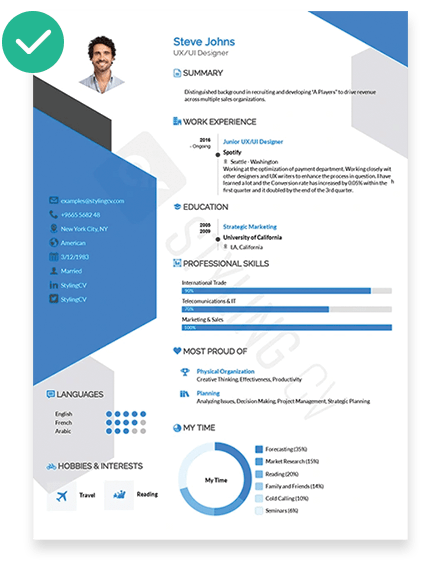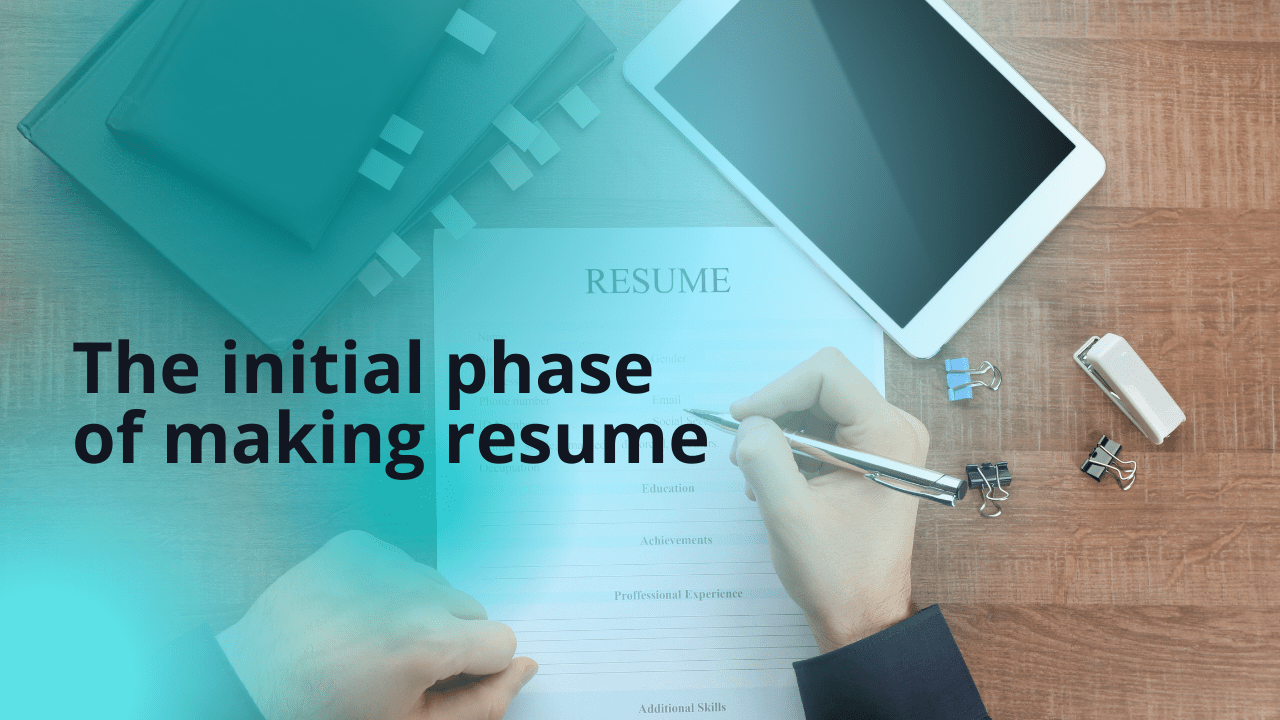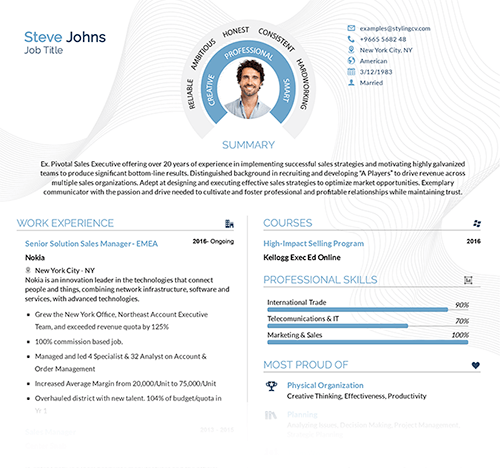
It’s no secret that landing an interview for a job can be a challenge, let alone landing the actual job itself. But when you know how to craft the perfect resume, you give yourself something that other candidates simply just don’t have – a chance! Thanks to this 10-step guide, you can be well on your way towards securing an interview with a well-crafted resume that’s specifically designed to draw the eyes of your interviewers.
Resume Help - Your 10-Step Guide To Writing The Perfect Resume
Get your free resume nowYour 10-Step Guide To Writing The Perfect Resume
It’s no secret that landing an interview for a job can be a challenge, let alone landing the actual job itself. But when you know how to craft the perfect resume, you give yourself something that other candidates simply just don’t have – a chance! Thanks to this 10-step guide, you can be well on your way towards securing an interview with a well-crafted resume that’s specifically designed to draw the eyes of your interviewers.
Sarah Reynolds
Content Specialist


Do you know how to write the perfect resume? It may seem like a daunting task, but it’s actually not that difficult. Read on for our 10-step guide on writing the perfect resume!
A summary of what you will find in this article:
- Get to know the resume.
- The steps for writing a resume are perfect.
- The most important questions about writing a resume.
- The most important tips that will help you with that.
Definition of the term “Resume”
Whether your career is just getting started or has been going for years, a resume is a summary of it, around one page in length.
It highlights the positions you’ve held and are now in, the duties you’ve taken on, the talents you’ve acquired, and the attributes you possess that make you a valuable employee.
All of those factors work together to make it very simple for any hiring manager to see your qualifications and suitability for a position.
Despite the effort you may have put into crafting your resume, hiring managers typically only give it a cursory glance, giving it only a few seconds of their time.
Nevertheless, it’s reasonable to say that creating a fantastic resume—as opposed to hurriedly putting one together—is still important.
Read more: 10 Essential Resume Sections
What Does an Employer Want to See on a Resume?
Three elements are looked for by hiring managers on a resume: “What did you do? Why did you do it? What was the outcome?
Martin McGovern, proprietor of Career Therapy and a Muse career consultant, says. “You’re going to be on the correct track if you can address all three of these issues in…your resume bullet points.”
The goal is to use simple, understandable language, the reality is that most resumes are illogical. These documents are overstuffed with jargon, overly technical, and redundant.
If you try to read a resume that isn’t yours, you will immediately notice that it reads like an alien authored it. Consider a recruiter who has no knowledge of how your job functions.
How can you make your resume understandable to them?
Additionally, the recruiting manager is interested in you in connection to them rather than just you and you alone.
According to Yurovsky, hiring managers aim to determine whether an applicant “meets the requirements” of the position they are filling.
“Your resume should portray this picture so the hiring manager not only knows what daily tasks you are capable of handling, but also why you, above others, offer value to their firm,” says the author.
How to write a perfect resume
Here are the top 10 steps to Writing The Perfect Resume:
1.The Right Format Makes All The Difference
For many, they just don’t realize how important it is to choose the correct format for their resume, traditionally, there are three distinct formats that should be used and they include:
- Reverse-chronological format, which is the most familiar to most applicants because it lists your most relevant experience first.
- Followed by combination format, which is excellent for seasoned professionals who want to highlight relevant skills that can be transferred to a new career.
- And lastly, functional format, which is entirely skills based.
Now, it’s important to remember that there are pros and cons for each of these formats, which is why you’ll want to choose the right format that suits your experience, your skills, and most importantly, your purposes.
2. Don’t Forget Your Contact Information
This may come as a surprise, but far too many applicants neglect to include their personal information and contact information on their resume – this is a big mistake!
But why? Because your interviewers want to learn more about you – other than simply reading about your experience on a piece of paper or on their screen. For instance, basic contact information is a must.
From there, you should include a link to your LinkedIn profile, so that your potential employer can learn more about what you can and have brought to the table.
You can even consider adding links to social media profiles, your website, a blog, or even a personal portfolio, but all of this comes after adding the basics like your name, title, mailing address, phone number, and email address.
And let’s just throw your LinkedIn profile here as well, it’s all relevant information for a potential employer!
3. Writing the perfect resume needs a good summary and says it all
The executive summary – also known as the heading statement – is an important component of a well-crafted resume that is not to be overlooked.
And remember, because your likely employer will be flipping through resumes faster than you can swipe through your camera roll on your phone, you’ll have to make sure that you hit the nail on the head.
Don’t just go through your daily duties – write clear, concise, and short sentences that list off your accomplishments, experience, and skills one by one. Also, be sure to avoid the first-person tense!
4. Keep It Relevant
Many resumes fail to list what we’d call “relevant” work experience.
Instead, applicants list every job they ever held – including their job at the bowling alley when they were 17.
Remember, whoever is going to read your resume will probably want to get through it in a matter of minutes, if not less, this is your chance to show your employer that you have relevant skills and experience that they’d be interested in.
Now, when it comes to listing your relevant experience, this is how you should do it:
- Job Title
- Location
- Timeline
- Responsibilities & Duties
- Achievements & Accolades
- Relevant Keywords
Why Are Resume Templates In MS Word BAD?

- It is a very old fashioned way to write a professional resume and takes along time to create.
- Anytime you need to update your resume it’s template breaks and you have to redo it all over again.
- Whenever you want to change the template you’ll spend hours just trying to figure what section goes where.

Sounds simple, right? Also, be sure to remember that when adding multiple job experiences to your resume, you do so following the correct chosen format. If you choose reverse-chronological format – you must be sure to put the most recent position first!

5. For writing the perfect resume, you have to make the education section simple
Believe it or not, education is always somewhat of a grey area for many job applicants.
Mostly because the ways in which it should be displayed on your resume are just too unclear.
Here, we’d like to simplify it for you and make it easier than ever to showcase your hard work in academia the right way.
So, first, you’d like you place your highest degree first, if you’ve earned a master’s degree, that should be listed at the top.
Everything else should follow suit in reverse-chronological order.
If you’ve gone to college, no high school information should be included because it’s simply not relevant.
From there, you can add any specialized courses that you’ve taken, any accolades and awards, or any honors.
Now, where exactly do you place your education section?
That depends on how much experience you have:
- If you’re seeking an entry level position, it’s okay to place your education information above your work experience.
- If you’re a seasoned professional, place it just below your work experience.
6. While writing the perfect resume, you must add your correct skills
There’s a difference between what we’d call hard skills and soft skills.
Hard skills
Hard skills are specific abilities that only few people know – for instance, perhaps you’re an amateur photographer and have become a master at Adobe Photoshop.
This could be an important skill that could separate your application from others – even if it has nothing to do with photography!
Soft skills
Soft skills, on the other hand, are skills that are learned simply through experience.
For example, these can include things like organization skills, leadership, adaptability, communication, and much more.
But when you combine your hard skills and soft skills together, you present a unique skillset for yourself that potential employers will be interested in.
But remember, always be sure to add the right skills – this means add only relevant skills to the position that you’re applying for.
So, if you’re applying to be a bookkeeper, your Photoshop abilities simply aren’t relevant!
7. Include Some Important Additional Sections for your resume
Resumes that warrant them can always benefit from some additional sections that can include things like your hobbies, your interests, any relevant volunteer work that you’ve done, certifications, awards, and the like.
However, this should only be done when your resume warrants it.
You can even include information like any publications or projects that have your name included, second languages, portfolio information, and much more.
As long as it’s relevant to the job that you’re applying for, it’s fair game!
Your success story begins with a resume

8. Don’t Ditch The Cover Letter
Similar to the executive summary, a cover letter is a must. And for far too many potential applicants, they miss out on the job of they’re dreams because they’re too reluctant to write a cover letter.
This critical piece of information can be considered your resume 2.0, It allows you to expand on your experience, to highlight the most important achievements in your career history to date, and it gives you the opportunity to quickly and clearly articulate just why you’re the most qualified candidate for a position.
And guess what? You can do it all in full, complete sentences.
9. Proofread Proofread Proofread your resume!
This should go without saying, but always be sure to proofread your resume before you save and send it out.
And before you do that, have someone else read and proofread it for you as well.
Double check your information for accuracy, use Spellcheck on Microsoft Word, use a third-party software like Grammarly, or bring it to someone who you trust.
Don’t miss out on your chance to secure an interview due to a misplaced comma, a forgotten period, or an incorrect date!
10. Be Confident!
Your last step in this 10-step guide to writing the perfect resume is simple – just be confident. As long as you’ve followed each and every step listed above to the detail, your final task is to remain confident in your abilities, confident in your resume, and confident in yourself to land the job that you’ve always wanted.
Read more: List of 100 Best Words to Describe Yourself [Adjectives & More]
FAQ about writing the perfect resume
1-What are the 5 golden rules of resume writing?
The 5 Golden Rules of resume Writing
- The Right Format Makes All The Difference.
- Don’t Forget Your Contact Information.
- Keep It Relevant.
- Don’t Ditch The Cover Letter.
2-What does a good resume look like in 2022?
We’d advise using a reverse-chronological resume structure in 99.9% of circumstances. It’s the most popular and practical format in 2022 since applicant tracking systems can easily understand it. This format is well-known to recruiting managers and recruiters alike.
3-What should you not put on a resume for 2022?
Limit the amount of information you include that is unrelated to the position you are applying for. Sure, you have interests, hobbies, languages, favorite songs, and goals.However, keep the information that doesn’t speak to your capacity for accountability, responsibility, and hard work to a reasonable level.
4-How far back should your resume go?
For the majority of industries, career advisors and expert resume writers advise you to concentrate on the last 10 to 15 years. (Some positions, such as those in the federal government or academia, frequently demand for more thorough career histories.)
Styling CV offers all solutions for your resume, and in the blog section you will find various articles on how to build a resume with many tips and instructions.
Sign up now and get many advantages in terms of building a resume and accessing various templates.
Related articles
Tags
Build your resume in 10 minutes
Use professional field-tested resume templates that follow the exact ‘resume rules’ employers look for. Create My Resume
BUILD MY RESUME NOW




